Question 1: For each of the following situations draw a graph that represents the situation. In your graph label the curve that represents the Marginal Social Cost (MSC) of producing the good, the Marginal Private Cost (MPC) of producing the good, the Marginal Social Benefit (MSB) of consuming the good, the Marginal Private Benefit (MPB) of consuming the good, the market provided quantity of the good (Qmkt), the socially optimal amount of the good (Qsoc opt), and the deadweight loss (DWL). Note that some graphs may not include each of these items.
a. Running red lights creates potential danger to pedestrians as well as other drivers. But, people run lights all the time because they consider just their additional private benefits from getting through the intersection a bit quicker than if they slow down and wait through a light's cycle. Provide a graph of the market outcome for running lights as well as depicting what the socially optimal amount of light running is. Indicate all the terms mentioned in the intro to this question in your answer.
b. NASA has pioneered many new technologies required for space exploration. Consider the market for robots. The work that NASA did in basic research and robot development has proved to have transferable effects for many production processes. Analyze the overall market for robots given these spillover effects. Provide a graph of the market outcome for robots as well as depicting what the socially optimal amount of robots is. Indicate all the terms mentioned in the intro to this question in your answer.
c. Joe and his group of freshmen friends (50 guys) really enjoy having a noisy good time starting on Thursday afternoon and running through the entire weekend. Most weekends this pack of guys drinks way too much and the result is that this group is often loud, raunchy, and very often violently sick. The group does not consider the impact of their actions on those who live around him. Provide a graph of the market outcome for alcohol consumption given this information. Make sure you identify the socially optimal amount of alcohol consumption. Indicate all the terms mentioned in the intro to this question in your answer.
Question 2: Consider the town of Morningside. Current debate in City Hall is over how many streetlights should be put up in the community. What is it about a streetlight that makes it a public good? (Hint: there should be two aspects of the streetlight that makes it a public good.) Why is the market unlikely to provide Morningside with the optimal number of streetlights?
Question 3: Economists are interested in the idea of the free ride and how free ridership can prevent a market from providing the socially optimal amount of the good. We have discussed several examples of free ridership in class (attending a review session even though you have not prepared any questions in hopes that you can "free ride" on the efforts of other students, walking past the kitchen garbage can when it was full and hoping that someone else will empty the garbage allowing you to "free ride" on their efforts, etc.); now, think of at least three examples where you have been a "free rider". Discuss the example and then discuss how you were a free rider. Is the problem with being a free rider a problem of the good being non-rival or non-excludable? Explain your answer.
Question 4: In class we discussed the Tragedy of the Commons and how it was first used as a term to discuss the over use of grazing ground in England. Let's return to Charles Wheelan's black rhinos in Chapter Two: how is the story of the black rhino an illustration of the Tragedy of the Commons? Write a nice, short essay explaining this to your Great Uncle Bernie who is trying hard to see how college is helping you have a better understanding of the issues facing the world. In your essay identify some solutions that might help address this problem.
Question 5: Mandy and Bob are Maine "lobstermen"; that is, both Mandy and Bob own lobster boats and they go out during the lobster season daily to catch lobsters. Mandy and Bob are aware that the overfishing of our coastal waters is an issue and they meet frequently with other people in the business to discuss what ought to be done. Bob knows that if he catches lobsters without restriction that his daily revenues during the season will be $1400. Mandy knows that if she catches lobsters without restriction that her daily revenues during the season will be $1000. If they catch lobster in this manner, in five years there will be no lobsters left to harvest. If both Mandy and Bob catch lobsters in a socially responsible manner, Bob's daily revenues will be $600 while Mandy's daily revenues will be $400 and these daily revenues will continue perpetually. If Bob hunts to his heart's content while Mandy hunts in a socially responsible manner, then Bob's daily revenues will be $1200 and Mandy's daily revenues will be $500. If Mandy hunts to her heart's content while Bob hunts in a socially responsible manner, then Mandy's revenues will be $900 and Bob's daily revenues will be $700. Catching lobsters in a socially responsible manner means taking into account the benefits of having a healthy population of lobsters in the future for their enjoyment, their children's enjoyment, and the enjoyment of other future consumers of lobster. Assume that Mandy and Bob only consider the value of the lobster they catch when deciding how they are going to run their businesses.
a. What are the two lobstering choices that Bob has to choose between given the above information?
b. What are the two lobstering choices that Mandy has to choose between given the above information?
c. Draw a payoff matrix illustrating the payoffs that Mandy and Bob face when considering their decision about how they catch lobster. Put Mandy on the left hand side of the matrix and Bob on the top of the matrix. In the matrix record the payoffs as (Mandy’s payoff, Bob’s payoff) in each cell.
d. Given the above information and your analysis, what lobster catching choice will Bob make?
e. Given the above information and your analysis, what fishingchoice willMandymake?
f. How does this example illustrate the Prisoner’s Dilemma? Is the fishing outcome that occurs the optimal one from the perspective of Bob and/or Mandy? Explain your answer.
Question 6: Suppose you are the President of a small country and you have decided to provide health insurance to all the residents of your country. You plan to provide this health insurance by first assessing how much money you will need to set aside per year to cover the health costs of your citizens; second, figuring out what each person would need to contribute if everyone contributed the same amount to insure that all would get health insurance coverage; third, figuring out how big a subsidy per person would need to be paid by the government in order that all could afford the health insurance; and fourth, figuring out how much more needs to be collected from the affluent in order to cover the costs of these subsidies for the lower income individuals.
Luckily you do have some information:
• The population of your country is 20 people; this population is constant over time.
• 5% of your population in any given year will have significant healthcare costs of $100,000 per person; 40% of your population in any given year will have some healthcare costs of $20,000 per person; and 55% of your population in any given year will have low healthcare costs of $2000 per person. No one in the population knows with certainty whether or not they will have significant healthcare costs, some health care costs, or low healthcare costs each year.
• You also have the following information about each individual in your country:
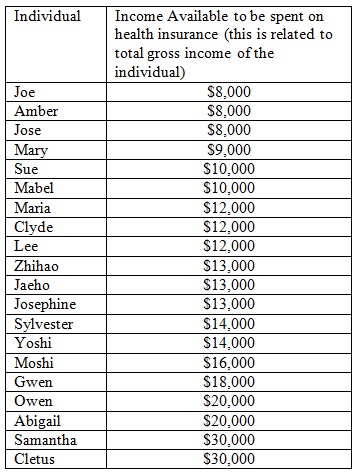
a. Given the above information calculate the amount of money you will need to collect in order to cover this year’s health care costs in your country. Use the following table to help you calculate these costs.
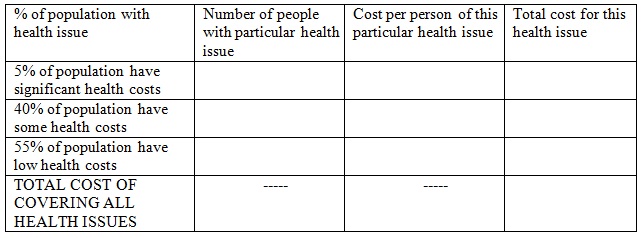
b. If everyone in the country is required to pay an equal amount for health insurance and the President wishes to collect a sufficient amount of funds to cover all health costs for the year, what payment will each individual be required to make?
c. Now that you have calculated the amount of money per person (the healthcare insurance premium) you will need to collect to cover the costs of the year’s health care, take the time to calculate how much additional money you will need to collect from the affluent in order to subsidize the lower income individuals when they go to purchase their health insurance. You will find it helpful to use the following table. Note: lest you think that this is an all-together dumb plan (against the Affordable Care Act) recall that in the U.S. our policy has been to provide healthcare even if you do not have insurance-and this healthcare cost does get past on to someone who has to pay in the form of a combination of higher taxes and higher medical costs.
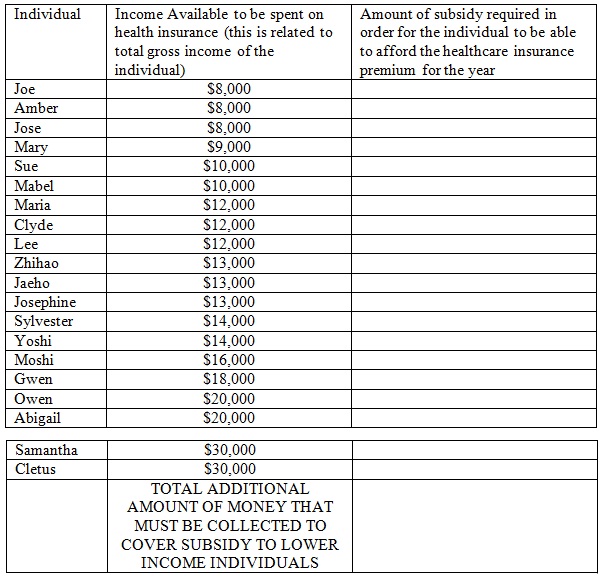
d. Suppose the cost of the healthcare insurance subsidy is divided among those who have more income available for health insurance than the amount of required premium. Start by divvying up the healthcare insurance premium so that no one supports the subsidy beyond the level of income they have available for health insurance; and then divide any remaining subsidy needed evenly among those individuals who still have funds available (you will need to think carefully here). Show how you found your answer. Also fill in the following table to consolidate your work in this problem. Remember that each individual cannot spend more than the amount of their income they have available for health insurance: this implies that you may have to do some thinking about the amount of subsidy that is being paid by lower income individuals.
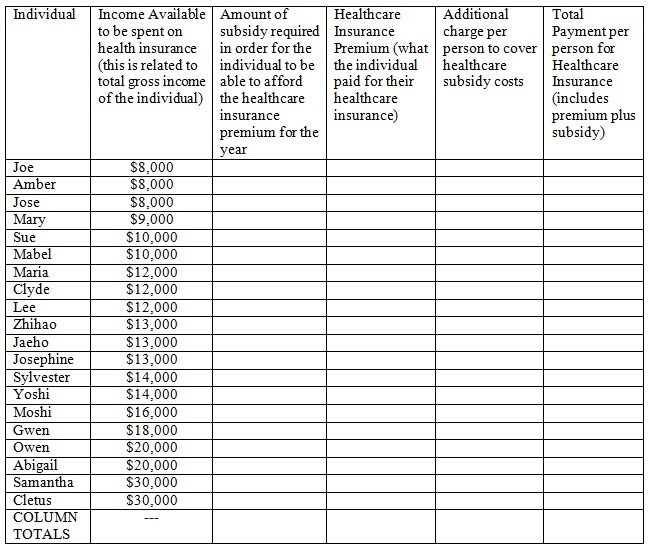
e. To further complicate this issue let’s imagine that people in this group actually know more about their healthcare situation than does the President. The following table tells us what they privately know about their healthcare situation for the coming year (assume that this information is completely accurate).
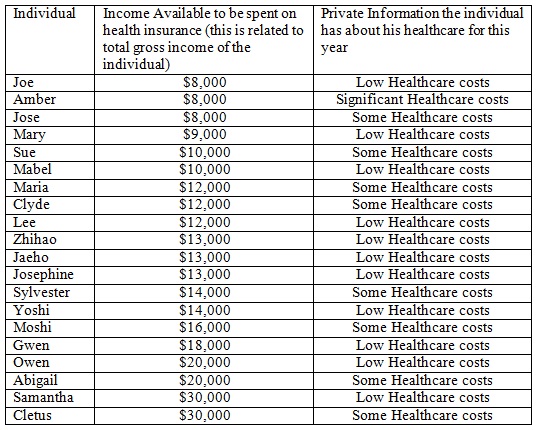
Given your answers in (b) and (d), make a prediction about whether or not each of these individuals will be willing to voluntarily pay into the healthcare pool. Assume that all individuals in this country consider only the financial costs to themselves of buying the healthcare insurance and their private healthcare information (that is, no one is altruistic in this community!). Use the following table to consolidate your predictions. Explain your answers.
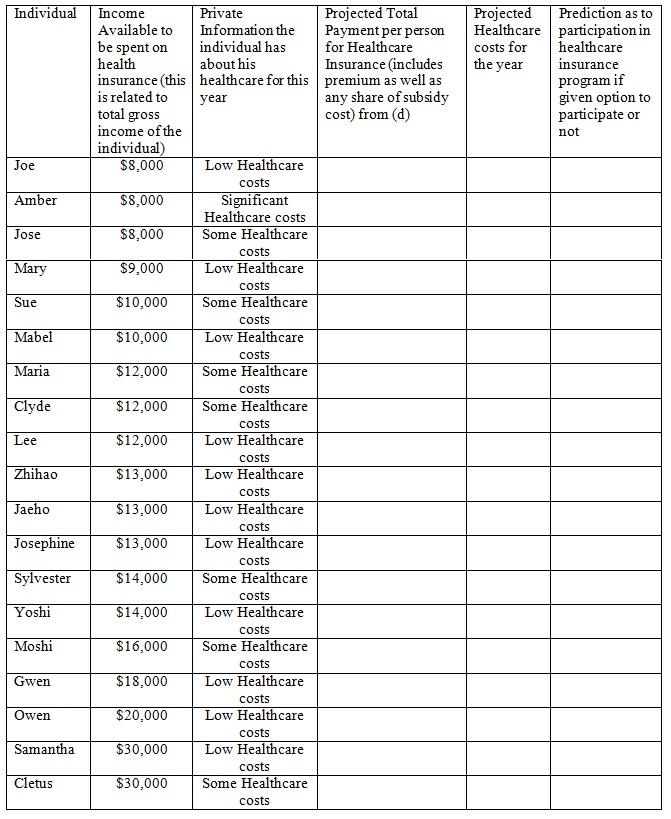
f. Given your work in this problem, provide a brief explanation of why the Affordable Care Act (“Obamacare”) includes both a subsidy for low income individuals as well as an Individual Mandate that requires everyone to purchase healthcare insurance.
Question 7. In class we have discussed trade using the production possibility frontier framework as well as the supply and demand model. You have also read your textbook on this topic as well as Chapters 12 and 13 in Naked Economics by Charles Wheelan. Write an essay on how your understanding of trade and its benefits has been affected by your work and reading in Economics 100. Be careful here: you know that your grader will want you to write crisply, concisely, and with clarity and your grade will be apt to quicker notice when you seem to be confused and befuddled in your explanations!
Question 8. Read Chapter 13 of Naked Economics by Charles Wheelan. Then, write a short outline of the chapter using standard outline format (in previous assignments I just said "outline", this time we will go with "standard outline format"). As always, if you quote from the text make sure you provide a reference: for this assignment the reference can take the form of "(page xxx)" following the quoted material. By standard outline format I mean that each level of outline must have a minimum of two entries and that we will go with the following style:
I.
A.
1.
2.
3.
B.
C.
II.
A.
B.
III.